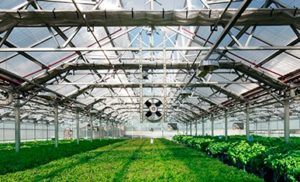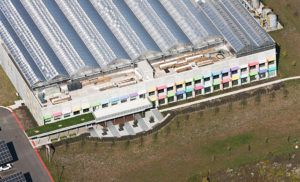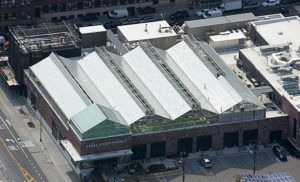Live from New York it’s Gotham Greens….Optimizing Crop Production, Crop Quality, and Food Safety in the Face of Global Warming

“We are farmers that live in apartments. We see green fields where others see rooftops. We fuel blooming communities where others fear urban decay. And we purvey the freshest produce grown on earth.”
As droughts and storms become more prevalent due to global warming, impacting the ability for farmers to properly anticipate and control growing conditions, it is crucial for grocery stores and other food service companies to identify alternative sources of fresh produce. Enter Gotham Greens (“Gotham” or the “Company”). Gotham not only helps to solve the problem by growing produce year-round in its controlled-climate, urban greenhouse facilities, but it also does so in an ecologically sustainable way, taking a variety of extra steps to mitigate its contributions to carbon emission and thus climate change.
Green-Eyed Monster Problem
According to the United States Environmental Protection Agency (“EPA”), changes in temperature, atmospheric carbon dioxide (CO2), and the frequency and intensity of extreme weather could have significant impacts on crop yields.1 The EPA also states that rising CO2 levels can ultimately decrease the nutritional value of crops, including drops in zinc, iron and protein.2,3 Furthermore, given the repercussions that water availability has on food production, droughts and irrigation system issues are catalyzing a need for creative answers to inevitable food shortage problems. Specialists have stated that “By 2030, overall demand for water may outstrip supply by 40%. And by 2090…global land surface in extreme drought could increase from 1% to 3% today to 30%”.4 In the face of that, companies whose business models depend on regular shipments of specific quantities of produce, predicting crop costs, and guaranteed food-safety standards, will struggle if they cannot find a way to supplant this supply chain hole.
Gotham’s Solution
Gotham has answered wholesalers’ cry for year-round, predictable, safe produce supply amidst erratic temperatures and confused climates by developing climate-controlled greenhouse facilities that are designed to allow expert growers to control the temperature, light, C02 and nutrition. Additional control systems such as heating, cooling and irrigation allow Gotham to promise consistent yields and high-quality products. Founded in 2009 in Brooklyn, Gotham has built and operates over 170,000 square feet of technologically advanced, urban rooftop greenhouses across 4 facilities.5 While greenhouse farming itself is not a new concept, Gotham has taken it to the next level by placing their hydroponic facilities in or next to cities in areas of the country where it’s usually harder to get fresh produce and where it usually has to be shipped from places like the West Coast. This simple concept is so powerful because it means that produce can go from “stalk-to-shelf” in sub-24 hours. According to the Oxford University economist Paul Watkiss, “We’re shifting goods around the world in a way that looks really bizarre…and we are not paying the environmental cost of all that travel”.6 Gotham’s well-located facilities alleviate some of these carbon emissions with the shortened transportation delivery cycles. Additionally, Gotham greenhouses yield ~20-30 times more produce per acre than field farming and given that they are built on rooftops, they do not add to over-construction problems in urban communities.7 Finally, Gotham offsets the large amount of energy it uses in its high-tech climate by using solar panels for a portion of the energy and then purchasing renewable energy through a utility company.8
The Proof in the Produce Partnerships
In 2013, Gotham and Whole Foods announced that Gotham would open the nation’s first commercial scale greenhouse farm integrated into a retail grocery space in Brooklyn.9 In the press release, Whole Foods not only focused on the fact that Gotham Greens had already been a trusted supplier for the past 2 years due to the quality of the produce, but also specifically highlighted the irrigation systems that would utilize 20 times less water than conventional farming as well as specific technological enhancements that would reduce energy demand.10 The alignment of incentives between Whole Foods and Gotham is clear: Whole Foods benefits from partnering with a reliable supplier of quality products that operates in line with their own mission as well as produce that will have a longer shelf life due to the more efficient delivery structure. Gotham benefits from a massive market opportunity as food wholesalers and retailers become more dependent on them due to worsening traditional farming conditions, all while also helping to improve the environment. (One disclaimer here is that Whole Foods has not yet discussed how it will handle the Gotham relationship post Amazon acquisition.)
This trend has extended beyond just grocery stores to major food groups such as Union Square Hospitality Group. John Karangis, the executive chef at USHG’s catering and partnership business, has said, “It’s the best basil we’ve ever had, and they’re able to produce it for us year-round.” Karangis went on to explain that Union Square Events purchased 11,000 pounds of produce from Gotham between March 2015 and March 2016 and that having access to Gotham has been a “game-changer.”7
Growing Like Weeds or Facing Drought?
Going forward, Gotham will have to grapple with how to stop the competition; competitors are already starting to appear in places such as Pennsylvania and Washington, DC. Does Gotham have enough of a first-mover advantage to keep wholesaler/retailer relationships in place? Is the produce high-quality enough to allow the Company to keep its leading position?
Additionally, Gotham will need to figure out how to expand the model beyond traditional grocery stores and restaurant groups. Partnerships with delivery services such as Blue Apron could prove to be very successful if Blue Apron is willing to add Gotham into its regular supply chain. (800 words)
1 Environmental Protection Agency: Climate Change Impacts, “Climate Impacts on Agriculture and Food Supply”, https://19january2017snapshot.epa.gov/climate-impacts/climate-impacts-agriculture-and-food-supply_.html, accessed November 2017
2 ibid
3 Henderson, R.M., et al, Climate Change in 2017: Implications for Business, page 4
4 ibid
5 Gotham Greens Website, “About Us”, http://gothamgreens.com/our-story/, accessed November 2017
6 New York Times, “Environmental Costs of Shipping Groceries Around the World,” http://www.nytimes.com/2008/04/26/business/worldbusiness/26food.html, accessed November 2017
7 Eater, “How Urban Farms Are Changing the Way We Eat,” https://www.eater.com/2016/4/12/11394458/urban-farm-greenhouse-brooklyn-chicago, accessed November 2017
8 ibid
9 Whole Foods Website, “Brooklyn Greenhouse: Gotham Greens”, http://www.wholefoodsmarket.com/service/brooklyn-greenhouse-gotham-greens, accessed November 2017
10 ibid






Gotham is a small first mover in an industry with huge volumes of production (170,000 sq ft of rooftop space in NYC versus the hundreds of millions of acres of farmland across the US). This valiant — and presumably very high cost — effort may be worthwhile for expensive produce, but it’s hard to imagine this method replacing the traditional agricultural supply chain. It’s no surprise that their basil reaches the Union Square Hospitality Group and Whole Foods, then. From a business viability perspective, I would agree with your conclusion that Gotham will need to expand beyond its partnerships with grocery stores and restaurant groups, but I slightly disagree that they’re working with “traditional” businesses. If we’re to take seriously Gotham’s value proposition about mitigating and adapting to climate change, I’d like to see them attempt to make this a feasible supply chain for Kroger, Safeway, and Chili’s.
Great article! This essay did a wonderful job at analyzing how Gotham Greens is not only addressing the impact of climate change on crop yields and the general predictability of the supply of produce, but also improving the speed-to-market by developing a local strategy. While I agree that a partnership with Whole Foods speaks to the promise of the company from both the retailer’s perspective as well as that of the consumer, I am concerned with the costs associated with this model. Are the cost savings for the retailer (i.e. minimizing spoilage, extending the life of produce in-store, reducing transportation time and spend) enough to command a premium against more traditional agriculture? Furthermore, can Gotham Greens expand in a cost-effective manner (i.e. identifying feasible real estate) and does this model work once it is expanded outside of urban centers? Assuming the company can expand efficiently, I think you are correct in stating the importance of Gotham developing partnerships beyond traditional grocery stores (especially outside of the higher-end market). If Gotham fails to secure its place in the market as an early mover in this space, I fear the company, as you highlight, will face steep competition and that Gotham Greens’ current competitive advantage will ultimately make it an attractive piece of the supply chain for retailers to take in-house.
Very interesting article. As mentioned by “USCA” above, I would be curious to know how the economics of Gotham’s produce compares to that of produce grown on a traditional farm. It seems that there are multiple areas of significant cost savings (less water use, more efficient/shorter transportation, use of solar energy, etc) – if Gotham could continue to optimize production costs such that they can sell produce at or below the level of the traditional food production industry, that would likely enable the company to expand into additional markets and expand rapidly. However, there are also significant upfront costs for Gotham to build new facilities which must be considered in the “breakeven economics.” For example, the Company recently received approval from the Rhode Island Commerce Board for $2.2 million in tax credits to build a new greenhouse in Providence (equivalent to roughly 10% of the total cost to build the facility) (1). While this is a positive sign (the Company is expanding into new markets and the public/government appear to be supportive) it also brings into question the economics of Gotham’s operations, and the Company’s ability to continue to expand without tax credits or other subsidies.
1. R.I. Commerce board OKs $2.2M in tax credits for massive greenhouse in Providence. Providence Journal. http://www.providencejournal.com/news/20171120/ri-commerce-board-oks-22m-in-tax-credits-for-massive-greenhouse-in-providence
I see this as a fascinating article but difficult to scale to the point where it would be able to shift the needle on the overall efficiency of food production. The model (which, as mentioned in some of the source article) includes manual planting is labour-intensive and requires high initial capex investment. The point at which ‘green’ greenhouse farming is economical compared to making conventional farming greener is in a marginal number of cases near cities.
More worryingly, it cannibalises the markets in big cities where people are most likely to put a premium on buying organic/ethically-sourced/environmentally friendly. This scale on the consumer demand side could be what is needed to shift mass producers to go to more environmentally-friendly production options.
Clearly they have shown innovation and similar to any other creation, competition will catch up, so I agree with the points made in that regard; however, it might also be highlighting the fact that Gotham has the opportunity to expand beyond New York and is leaving that opportunity on the table for others to grab. I’m left with this question: Does Gotham realize there is limited roof space available and they need to expand their footprint before they can expand their customer base? Is there a reason they didn’t consider places like DC and PA until the competitors did? Being a tier one supplier in this chain, they should focus both on the customer(s) at various levels as well as their asset supplier(s). Also, have they considered channels beyond just the direct channel to customers (Grocery stores & restaurants)? Are there opportunities to engage with wholesalers? They are ahead of the game at this point and with proper supply chain structure, they have the ability to shift that segment and not just have a profitable firm. Really innovative and a great place to start fighting the inevitable.